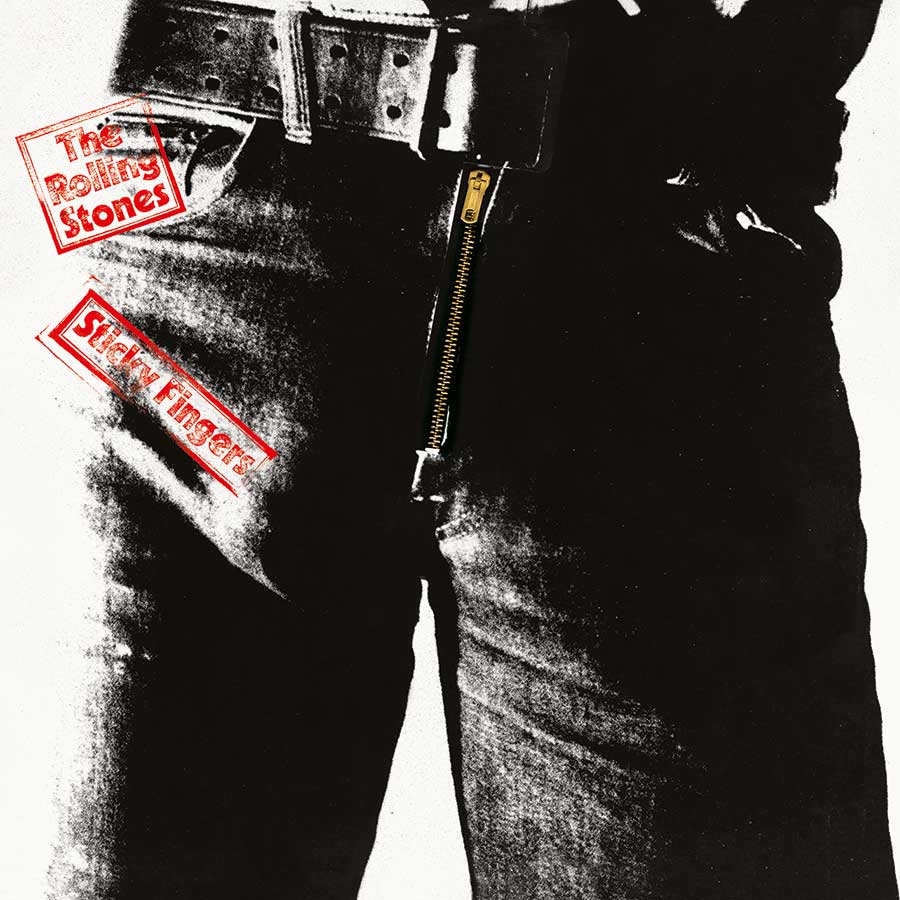
It seems like only yesterday, but April 2021 actually marked the 50th anniversary of the Rolling Stones iconic album Sticky Fingers. Released in 1971, the album was the first one on the Stones’ own label, Rolling Stones Records. The band felt an artistic and musical freedom that they hadn’t had before, when they were tied to Decca/London and their previous manager, Allen Klein. It also marked the first time that the band had a #1 album on both the UK and US album charts. That success was duplicated in many countries including Germany, Spain, Australia, and Canada.
The Stones’ new found artistic freedom was immediately evident by the album cover alone, which featured an actual zipper imbedded on the front. But more on that later.
For the first time, this was their new permanent line-up: Mick Jagger (lead vocal, various percussion and rhythm guitar), Keith Richards (guitar and backing vocal), Mick Taylor (guitar), Bill Wyman (bass guitar), and Charlie Watts (drums).
So put on your headphones and stream the whole record – or even better yet, drop the needle on your vinyl copy – as you check out these eight fascinating facts about the Rolling Stones’ Sticky Fingers.
01 The Cover Art – Part 1
The photo on the cover of the Sticky Fingers album cover became almost as big a selling point as the actual music it housed. The photograph was shot by Andy Warhol, whose idea it was to imbed an actual zipper into the cover. There have been many theories as to who the well-endowed model was (most thought it was Mick Jagger himself), but it turns out it was Warhol’s friend and makeup artist Corey Grant Tippin. But, Tippin wasn’t the only model. The inside “tighty-whities” model was Glenn O’Brien, editor of Warhol’s Interview magazine. The inside photo was shot later, after Art Director Craig Braun realized that the vinyl disc would be physically dented or scratched if he didn’t add an additional layer to separate the zipper from the vinyl.
The cover also had to be changed for several countries. In Spain, the photo was replaced by a picture of a woman’s fingers dripping in blood; In Russia, they added an image of a Soviet Army belt buckle to the jeans.
Here’s what the final Sticky Fingers artwork cost the Rolling Stones:
Corey Grant Tippin model fee: $75
Glenn O’Brien model fee: $100
Andy Warhol photos: $4000
Art Director Craig Braun: $300,000
Total Cost: $304,175
Value: Priceless!
02 The Cover Art – Part 2
As you can imagine, having a real zipper on the cover posed many logistical problems, from production to shipping. The biggest issue that happened was that the first shipments arrived with damages to the track “Sister Morphine” on the record. The weight of the albums in the packing boxes was indenting the zipper’s pull into the vinyl. Craig Braun brilliantly figured out that if they were to pull the zipper down prior to packing, the zipper pull would instead only dent the center disc label and therefore, not affect the way it played.
Braun is also credited with revising the original “tongue and lips” logo and creating what is now widely known as the “red official version,” perhaps the most famous band logo of all-time that doesn’t reference the name of the band at all.
Braun was nominated for a GRAMMY Award in 1971 for the Sticky Fingers cover. It was widely assumed that he would be the winner and everyone was prepared for his speech. But, in true Grammy fashion, the actual best album package award went to the designers of the self-titled album from Pollution – a blues-rock band.
Braun went on to win a GRAMMY in 1974 for the Who’s Tommy album packaging. Fun fact: he is now an acclaimed actor in shows such as Billions and Law & Order Special Victims Unit.
03 The Songs That Took 500 Days
Several of the songs on Sticky Fingers have become mainstays of rock playlists and of the Rolling Stones’ live repertoire including “Brown Sugar,” “Wild Horses,” “Can’t You Hear Me Knocking” and “Bitch.” The album percolated for about 500 days from start to finish, as the Stones recorded in numerous places, and also had a huge European tour commitment. In addition, they were creating their own record label and branching out artistically on their own, while fighting onerous tax bills in England.
04 Muscle Shoals Sound Studio
Three of the songs at the heart of the album – “Brown Sugar,” “You Gotta Move” and “Wild Horses” were recorded at the now legendary Muscle Shoals Sound Studio in tiny Sheffield, Alabama. This was quite a departure from the Rolling Stones previous recordings at the glossy RCA studios in Hollywood and at Chess Records in Chicago. Although the Stones were only at Muscle Shoals for three days in late 1969, Keith Richards has said, “I thought it was one of the easiest and rockingest sessions that we’d ever done. I don’t think we’ve been quite so prolific … ever.”
Guitarist Jimmy Johnson, a member of “The Swampers” made famous in Lynyrd Skynyrd’s “Sweet Home Alabama,” accidentally served as producer of the tracks when the Rolling Stones usual producer, Jimmy Miller, failed to show up. In addition, another local, Jimmy Dickinson, ended up playing piano parts on “Wild Horses” after Keith Richards heard him tinkering on the legendary upright “honky tonk” piano in the studio.
05 Mick Taylor
Some say the biggest impact on Sticky Fingers was the introduction of Mick Taylor as an official member of the group. Taylor replaced troubled guitarist Brian Jones, who was let go from the band in mid-1969 and then tragically drowned several days later. Recruited from John Mayall’s Bluesbreakers, Taylor and Keith Richards immediately hit their musical stride, inventing sort of a “weaving” style of seamless transitions between the two guitarists. Even the normally silent Charlie Watts said, “The Mick Taylor years were an an extremely important phase for the band. It was a creative peak for us. A tremendous jump in musical credibility.”
06 Additional Players
Saxophonist Bobby Keys, trumpeter Jim Price, keyboardists Billy Preston and Nicky Hopkins, slide guitarist Ry Cooder and road manager and keyboardist Ian Stewart all infused the final touches to the already exemplary songs and gave the record a more “bluesy” feel. Many of these musicians were almost like members of the band – in fact Stewart was an original member, only pushed out by management. In any event, the Stones were comfortable with them, and they were comfortable with the Stones, many of them touring and recording with the Stones for decades.
Backstage Access:
Where the Ronnie Wood Doc Missed the Mark, and Why It’s Still Worth the Watch
06 “Wild Horses”
Did you know that “Wild Horses” was recorded by Gram Parsons a year before it appeared on Sticky Fingers? Turns out that Keith Richards and Gram Parsons had a very close relationship, fueled by songwriting and drugs, and Parsons may have been misled into thinking that the Stones had given the song to him as a gift. Pamela Des Barres, author and famous rock and roll groupie, says, “Parsons was under the influence that the song was a gift. SOME even say that Gram actually helped write ‘Wild Horses.’ Mick’s brother, Chris, told Uncut mag back in ’13 that it was definitely a Parsons composition… Either way, when Chris and Gram invited Miss Mercy and me to A&M studios to the recording session for this glorious composition, Gram proudly insisted that Mick and Keith had given it to him for the Flying Burritos to cover.” The song was credited to Jagger and Richards, and no one seems to have had any issue with the release.
08 “Brown Sugar”
The first single released from Sticky Fingers was “Brown Sugar,” which turned out to be a good choice since it hit the top of the charts wherever it was played. The song was first debuted live at the infamous Altamont concert (at Mick Taylor’s request) only two days after it was recorded at Muscle Shoals. When writing the lyrics, Jagger knew he was confronting controversial subjects. He has stated, “The lyric was all to do with the dual combination of drugs and girls. The lewd and ambiguous lyrics makes it… the whole mess thrown in. God knows what I’m on about on that song. It’s such a mishmash. All the nasty subjects in one go… I never would write that song now.” Ex-girlfriend Marsha Hunt (and mother of Jagger’s first child) has always believed that the song is about her, but both Bill Wyman and former Ikette, Claudia Lennear, believe it is about Lennear, because she was Mick’s girlfriend at the time. Either way, there’s a good possibility that the song could not be released in today’s current climate.
08 The Legacy
Great packaging. Great players. Sticky Fingers had it all and has received numerous accolades. The album was listed as #63 on Rolling Stone magazine’s “500 Greatest Albums of All Time.” In 1999, the album was inducted into the Grammy Hall of Fame. In 2003, VH1 ranked Sticky Fingers as the greatest album cover of all time.










